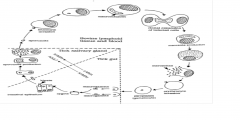![]()
![]()
![]()
Use LEFT and RIGHT arrow keys to navigate between flashcards;
Use UP and DOWN arrow keys to flip the card;
H to show hint;
A reads text to speech;
5 Cards in this Set
- Front
- Back
|
in lecture 1 it says that ixodes ricinus can cause tick born fever in ruminants and dogs. It is caused by a gram -ve bac. name it and state the sub type responsible and what other type of this bac. can cause what disease. what genera of protazoa are important in tropical regions in relation to ruminants.
|
rikettsia bacteria- anaplasma causes tick born fever and cowdria ( ehrlichia)
these bac and the following are imp in tropical regions for rum.-protazoa- babesia and thileria ( order piroplasmida ) |
|
|
the protazoa genus theileria is futher devided into what 2 sp. of thileria. what are they, what is their vector, distribution and disease.
|

both pathogenic in cattle...
T.parva - brown ear tick ( ripicephalus appendiculatus-only found s of the sahara/ 3 host tick and trans stadial rout. Di)/ east cost fever ( very pathogenic in naive animals and around 100%)/ only found in E. and central Africa. T.Annulata -Hyalomma ticks ( 2 host usually and trans stadial rout)/ tropical theileriosis ( up to 70 % mortality in exotic animals and less pathogenic in native breeds but productivity lost)/ more wide spred - N. africa/middle east/ asia/s EU |
|
|
describe in detail the life cycle of theileria ( parva or annulata)
|

RUMINANTS (mainly cattle)- the tick inoculates the sporozoite when feeding- enters leukocyte and forms macroschizont, it stimulates the cell to devide and the macroschizont devides along with it by attaching to the mitotic spindle- after a set time the cell devision slows and the macroschizont then expands to iorm many merozoites. the leukocyte ruptures- merozoites invade RBCs and form gametocytes.
TICK (T.ANULATA-HYALOMMA/T.PARVA BROWN EAR TICK)- same as babesia except no migration to larvae, instead the kinete migrates when molting occurs. 'when in the tick the gametocyte will be released and form gametes which will fuse to produce a zygote which will invade the ticks gut epi cells and x to form kinetes. the kinetes will invade tissue including the ovaries and eggs of the tick so will infect the next generation. when they develope to larvae the kinetes will migrate to the salivary glands of the ticks and form sporozoites which will infect animals when the tick is feeding' |
|
|
describe the pathogenesis of east cost fever (Theileria parva. ) does it have a incubation period like babesia.
then describe the pathogenesis of tropical theileriosis ( theileria annulata ) does it have an incubation peiord like babesia. |
east cost fever-yes- incubation is about 1 week.
overall - severe damage to the lymphoid system. enlarged lymph nodes- bloody diarrhoea- plumonary oedema -systemic infection - death within 20 days roughly. tropical thelieriosis - no incubation peiord. lymph nodes enlarge - anaemia- blood diarrhea |
|
|
treatment of theileria
|
dipping/ drugs/ vaccine
|

